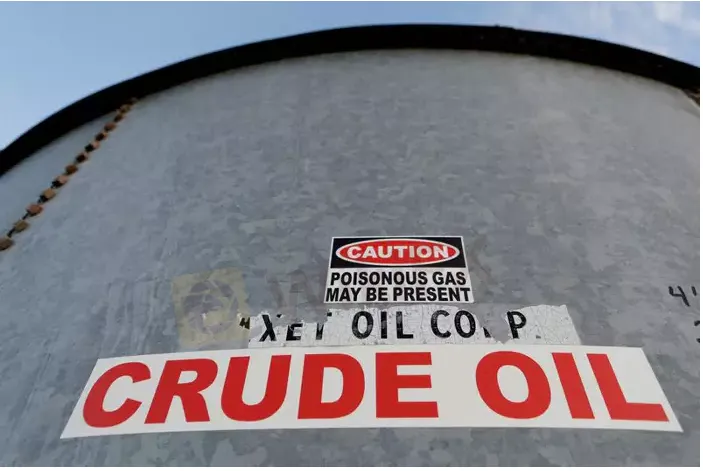简体中文
繁體中文
English
Pусский
日本語
ภาษาไทย
Tiếng Việt
Bahasa Indonesia
Español
हिन्दी
Filippiiniläinen
Français
Deutsch
Português
Türkçe
한국어
العربية
Oil prices fall as weak factory data fuels global demand concerns
Abstract:Oil prices dropped again on Tuesday as investors absorbed a bleak outlook for fuel demand with data pointing to a global manufacturing downturn just as major crude producers meet this week to determine whether to increase supply.

Brent crude futures fell 77 cents, or 0.8%, to $99.26 a barrel by 0421 GMT, while WTI crude futures eased 67 cents, or 0.7%, to $93.22 a barrel.
The slide came after Brent futures slumped on Monday to a session low of $99.09 a barrel, their lowest since July 15. The U.S. crude benchmark dropped to as low as $92.42 a barrel, its weakest since July 14.
“Crude prices tumbled after a wealth of factory activity data suggested the world is headed towards a giant global economic contraction, and on expectations for more oil output following a very good earnings season for oil companies,” said Edward Moya, senior market analyst from OANDA, in a note.
Recessionary concerns were heightened on Monday as surveys from the United States, Europe and Asia showed that factories struggled for momentum in July. Flagging global demand and Chinas strict COVID-19 restrictions slowed production.
The price drops also come as market participants await the outcome of a meeting on Wednesday between the Organization of the Petroleum Exporting Countries (OPEC) and allies including Russia, together known as OPEC+, to decide on September output.
Two of eight OPEC+ sources in a Reuters survey said that a modest increase for September would be discussed at the Aug. 3 meeting. The rest said output is likely to be held steady.
A Fox Business news reporter said Saudi Arabia will push OPEC+ to increase oil production at the meeting.
“The upward momentums of oil prices has been gradually fading … Once the supply and demand situation shows any sign of further deterioration, oil is likely to lead the decline among commodities,” analysts from Haitong Futures said.
Meanwhile the United States on Monday imposed sanctions on Chinese and other firms it said helped to sell tens of millions of dollars in Iranian oil and petrochemical products to East Asia as it seeks to raise pressure on Tehran to curb its nuclear programme.

Disclaimer:
The views in this article only represent the author's personal views, and do not constitute investment advice on this platform. This platform does not guarantee the accuracy, completeness and timeliness of the information in the article, and will not be liable for any loss caused by the use of or reliance on the information in the article.
Read more

How to Use Retracement in Trading
Understanding retracement is essential for strategic trading. In today’s article, we will focus on the retracement is a temporary, short-lived pullback in the price of a financial instrument, like a stock or an index, that occurs within a larger, established trend. Think of it as a brief pause or a correction before the market continues its original movement. Unlike a trend reversal, which signals a fundamental shift in direction, a retracement represents a temporary deviation that doesn't jeopardize the long-term trend.

What Is Indices in Forex? A Beginner’s Guide to Trading Forex Indices
Understand what indices in forex are, how DXY works, key differences vs pairs, pros/cons, and where to trade CFDs—beginner-friendly, expert-backed guide.

Malaysian Finfluencers Could Face RM10 Million Fine or 10 Years in Prison!
A new regulatory measure by the Securities Commission Malaysia (SC) is set to change the country’s online trading and financial influencer landscape. Starting 1 November 2025, any trader or influencer caught promoting an unlicensed broker could face a fine of up to RM10 million, a prison sentence of up to 10 years, or both.

Juno Markets: A Closer Look at Its Licenses
When selecting a broker, understanding its regulatory standing is an important part of assessing overall reliability. For traders seeking to protect their capital, ensuring that a platform operates under recognised and stringent oversight can make all the difference. Keep reading to learn more about Juno Markets and its licenses.
WikiFX Broker
Latest News
What Is Indices in Forex? A Beginner’s Guide to Trading Forex Indices
How to Use Retracement in Trading
CySEC warns the public against 17 investment websites
Robinhood Moves Toward MENA Expansion with Dubai DFSA License Application
FBI Issues Urgent Warning on Crypto Recovery Scams
Join WikiFX’s Agent Growth Event | Turn Your Success into a Global Achievement
Forex Trends Explained for Your Successful Trading Experience
Do Kwon Faces 130-Year Prison Sentence After Guilty Plea in $40B Crypto Collapse
Best 5 Low-Spread FX Brokers in India 2025
Major Pairs in Forex: Top Traded Currency Insights
Currency Calculator


